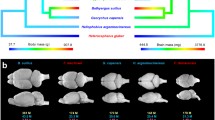Abstract
Eusociality in mammals is defined in the present paper by the following criteria: reproductive altruism (which involves reproductive division of labor and cooperative alloparental brood care), overlap of adult generations, and permanent (lifelong) philopatry. We argue that additional criteria such as the existence of castes, colony size, reproductive skew, and social cohesion are not pertinent to the definition of eusociality in mammals. According to our definition of mammalian eusociality, several rodent species of the African family Bathyergidae can be considered eusocial, including the naked mole-rat (Heterocephalus glaber), Damaraland mole-rat (Cryptomys damarensis), and several additional, if not all, species in the genus Cryptomys. Furthermore, some species of social voles (like Microtus ochrogaster) may also fulfill criteria of mammalian eusociality. Understanding the evolution of eusociality in mole-rats requires answers to two primary questions: (1) What are the preconditions for the development of their eusocial systems? (2) Why do offspring remain in the natal group rather than dispersing and reproducing? Eusociality in mammals is by definition a special case of monogamy (more specifically: monogyny one female breeding), involving prolonged pair bonding for more than one breeding period. We argue that eusociality in mole-rats evolved from a monogamous mating system where cooperative brood care was already established. A tendency for group living is considered to be an ancestral (plesiomorph) trait among African bathyergid mole-rats, linking them to other hystricognath rodents. A solitary lifestyle seen in some genera, such as Bathyergus, Georychus, and Heliophobius, is assumed to be a derived trait that arose independently in different lineages of bathyergids, possibly as a consequence of selective constraints associated with the subterranean environment. In proximate terms, in eusocial mole-rats either puberty is assumed to be developmentally delayed so that under natural conditions most animals die before dispersal is triggered (e.g., in the case of Heterocephalus) or dispersal is induced only by an incidental encounter with an unfamiliar, yet adequate sexual partner (e.g., in the case of Cryptomys). Ultimately, a combination of strategies involving either dispersal and/or philopatry can be beneficial, especially in a highly unpredictable environment. If genetic relatedness among siblings is high (e.g., a coefficient of relatedness of 0.5 or more), then philopatry would not invoke an appreciable loss of fitness, especially if the cost of dispersing is higher than staying within the natal group. High genetic relatedness is more likely in a monogamous mating system or a highly inbred population. In this paper, we argue that the preconditions for eusociality in bathyergid mole-rats were a monogamous mating system and high genetic relatedness among individuals. We argue against the aridity food-distribution hypothesis (AFDH) that suggests a causal relationship between cooperative foraging for patchily distributed resources and the origin of eusociality. The AFDH may explain group size dynamics of social mole-rats as a function of the distribution and availability of resources but it is inadequate to explain the formation of eusocial societies of mole-rats, especially with respect to providing preconditions conducive for the emergence of eusociality.
Similar content being viewed by others
Author information
Authors and Affiliations
Additional information
Received: 19 April 1999 / Received in revised form: 10 December 1999 / Accepted: 23 January 2000
Rights and permissions
About this article
Cite this article
Burda, H., Honeycutt, R., Begall, S. et al. Are naked and common mole-rats eusocial and if so, why?. Behav Ecol Sociobiol 47, 293–303 (2000). https://doi.org/10.1007/s002650050669
Issue Date:
DOI: https://doi.org/10.1007/s002650050669



